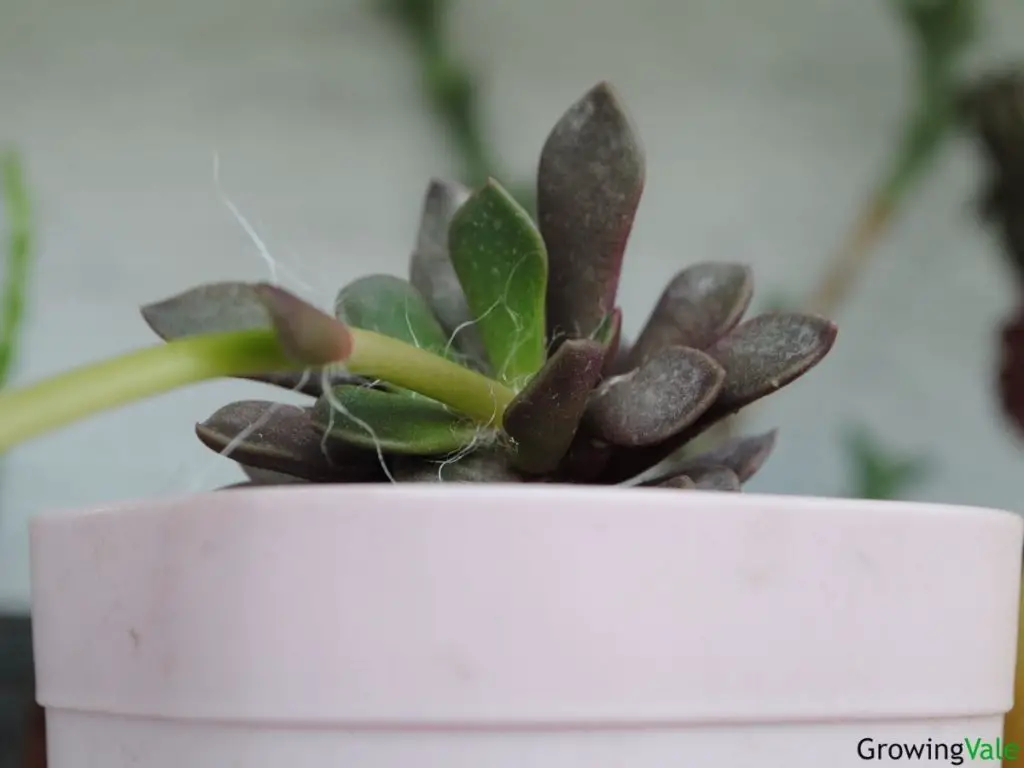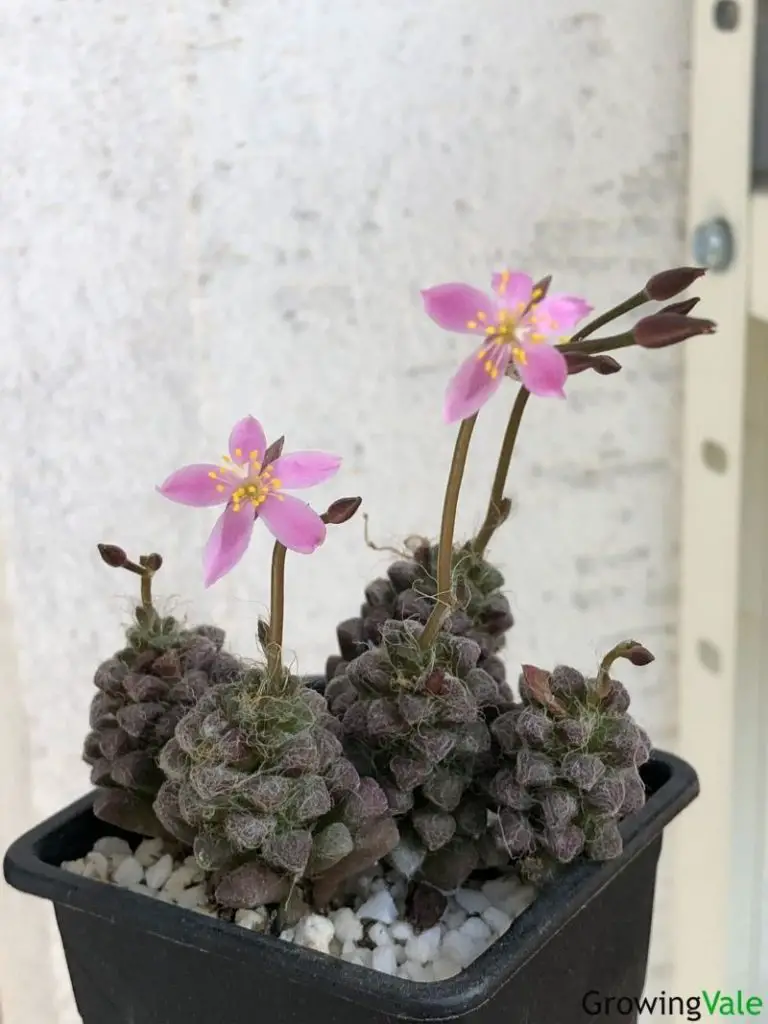Anacampseros are a small group of succulents that originated from South Africa. There are about 100 species in this genus.
They are generally low-growing plants that can be characterized by their small, very fleshy leaves. These are mainly different shades of green but many have tinges of red and purple, especially when grown in full sun.
These delicately-looking plants are very suitable for growing indoors in pots as long as they get plenty of sunlight. They might look delicate but they’re actually quite easy to care for.
These plants can also be grown outdoors if you live in an area with mild winters as they dislike the cold. Some species can spread, so these make great groundcovers when grouped together in a rock garden.
History
Anacampseros is an ancient botanical name for herbs that are supposed to restore lost love. Previously, the genus was in the family ‘Portulacaceae’ but was transferred to the newly created family ‘Anacampserotaceae in 2010.

The name Anacampseros was first used by Linnaeus in 1758 for the species Anacampseros telephiastrum DC. The botanical name came from the Greek words ‘anakamptein’ which means “bring back” and ‘eros’ which means “love”.
Plant Facts
| Scientific name | Anacampseros |
| Common names | Sunrise succulent, Sand Rose, Pan American Love Plant |
| Genus | Anacampseros |
| Family | Anacampserotaceae |
| Height | 24 inches |
| Width | 24 inches |
| USDA Plant Hardiness Zone | 9 to 11 |
| Origin | South Africa |
| Flower colors | Pink, white & purple |
| Blooming season | Summer |
| Plant/Flower special features | The flowers only open during the day and will close at night. |
How to Plant and Grow Anacampseros
Anacampseros are virtually maintenance-free plants that require very little water, bright light, and regular fertilizing in spring and summer. The plants go into dormancy in winter and can be left alone except for some water once a month.

How to Propagate Anacampseros
Anacampseros can be propagated from individual leaf cuttings. Use a sharp knife to cut some leaves from the plant. Place these leaves in a dry spot and wait for the cut end to callus.
Using a cactus or succulent mix is ideal for the propagating medium. Otherwise, you can make your own by mixing coco fiber with coarse builder’s sand and perlite.
To help stimulate faster root growth, dip the cut ends of the leaves into some rooting hormone. Then, pop into the mix and mist well. Don’t let the soil dry out while you’re waiting for roots to form.
These succulents can also be grown from seeds. Use the same mix as above to sow the seeds into. Keep the pot in a warm spot and water when dry until you see some sprouts coming up. To help speed up germination, you can place the pot or tray with the seeds on a warming pad.
Care and Maintenance
The most important thing to remember when caring for this succulent is not to overwater it and to give it plenty of warmth and indirect sunlight.
Soil
Anacampseros prefer well-drained soil that contains some sand or grit. If growing indoors in a pot, you can use specialized succulent or cacti mix.
Water

Due to their thick, fleshy leaves, these succulents are quite drought-hardy and don’t like to receive an overabundance of water. Anacampseros prefers the soil to dry out before you add more water.
In spring and summer, you can water once a week as long as the soil has time to dry out first. Then, in the cooler months in fall and winter, you should reduce the watering to once a month. During this time, the plant will be dormant.
Be sure to never allow the plant roots to sit in water because this will cause them to rot. When watering, it’s best to take the plant to the sink, water thoroughly, and then ensure that all the excess water drains away.
Fertilizer
You can apply a diluted solution of liquid fertilizer every two weeks during spring and summer to encourage growth and flowering. There are also fertilizers that are specifically designed for cacti and succulents that you might want to consider.
Sunlight
Anacampseros will happily grow in full sunlight but you should give the plant some protection from the hot afternoon sun. Otherwise, you may find that the leaves will get sunburnt.
However, the more sunlight that the plant receives, the more vivid the colors of the leaves will be. Therefore, if your plants are growing indoors, make sure that you place them near a bright window. Consider planting a couple of different species in a long pot that fits nicely on your window sill.
This will give you a delightful display when the plants start to flower in warmer weather.
Temperature and Humidity
Anacampseros prefer warm temperatures and will die if they’re exposed to the cold. The ideal temperature for this succulent is between 20 to 50 degrees Fahrenheit.
Pruning
Anacampseros does not require regular pruning. However, you should remove any damaged or rotten leaves when you see them.
Pest and diseases
Although relatively pest-free, Anacampseros can sometimes attract indoor pests such as mealybugs and red spider mites. You can get rid of these pests by using isopropyl alcohol for mealybugs and neem oil or insecticidal soap for red spider mites.
Uses of Anacampseros
Anacampseros is a useful houseplant as its growth habit is quite small and the plant is fairly low-maintenance. It is often used to add interest to a room in interior design. It can be planted in interesting containers to complement the interior landscape.
This succulent can also be useful as a ground cover in mild, temperate regions and in rock gardens.
There is not a lot of research available to determine whether these plants are toxic to animals or humans. However, ingesting parts of the leaves can cause digestive distress. If you have pets or small children, it’s best to keep them away from these plants.
Common Varieties and Cultivars
Here are some common anacampseros varieties and types:
- Anacampseros rufescens
- Anacampseros baeseckei
- Anacampseros telephiastrum
- Anacampseros crinita
- Anacampseros filamentosa
- Anacampseros retusa
- A. telephiastrum ‘Variegata’
Conclusion
Anacampseros are delightful small growing types of succulents that make ideal houseplants as long as you give them plenty of bright light and minimal watering. These succulents also prefer regular diluted fertilizer during spring and summer.
*References
Reference list:
https://www.itis.gov/servlet/SingleRpt/SingleRpt?search_topic=TSN&search_value=847585#null
”Close”

